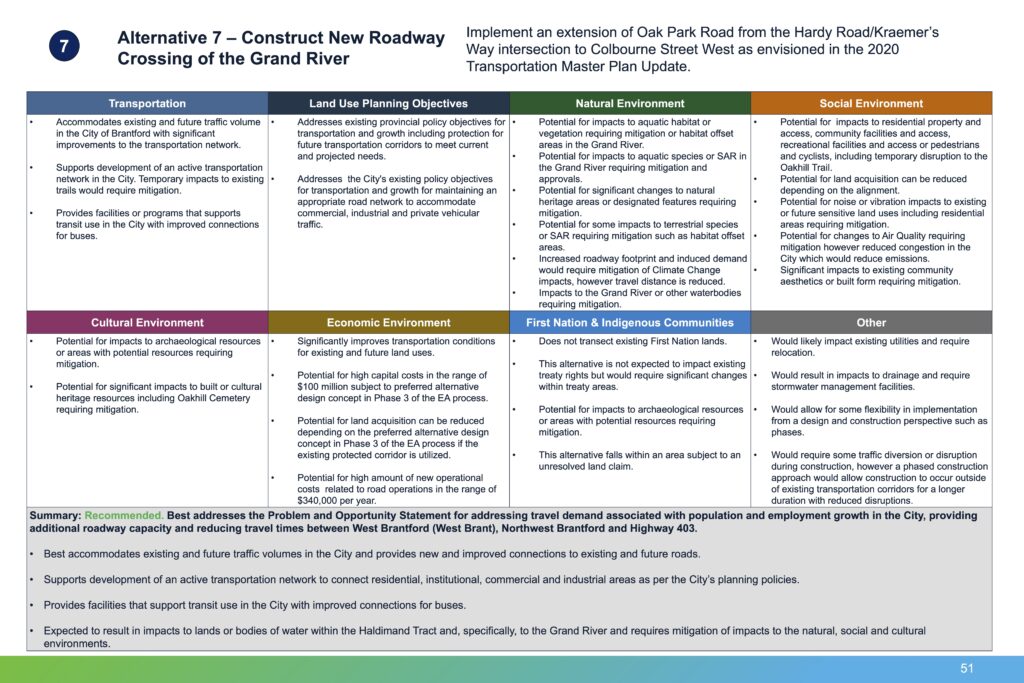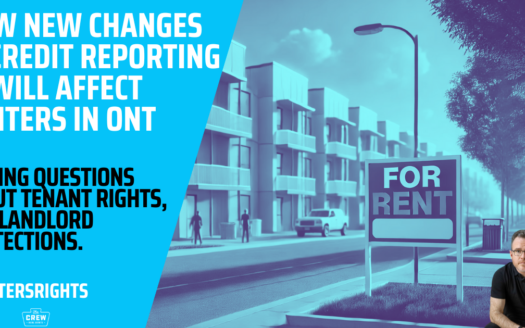Brantford’s Oak Park Road Extension: A 60-Year Detour in City Planning
As reported in an April 18, 2025 article by the Brantford Expositor, the Oak Park Road Extension is set to return to city council’s agenda in the fall. City staff will be revisiting the Environmental Assessment process with updated data and community input. According to the article, city officials recognize the challenge of balancing infrastructure needs with environmental protection and plan to use this next phase to better address public concerns. This renewed momentum suggests the project is far from dead, but it also reaffirms how long Brantford has gone without firm direction.
TL;DR
- The Oak Park Road Extension (OPRE) has been planned since the 1950s but remains unbuilt.
- The city faces pressure from residents, environmental advocates, and developers as traffic worsens in Southwest Brantford.
- A new Grand River crossing (Alternative 7) is now the preferred route, but it runs through ecologically sensitive areas.
- City officials support the project as a growth enabler and support system, while residents express strong opposition over cost, environment, and community impact.
- Neighbouring cities like Guelph, Cambridge, and Burlington took different approaches—some phased in projects, others canceled them entirely.
- Brantford must now decide whether to proceed, abandon, or rethink the OPRE in light of environmental and urban growth realities.
A Road in Theory: The Oak Park Road Extension
The Oak Park Road Extension has become Brantford’s most infamous piece of paper. From its first mention in 1958 to the 1981 Brantford Corridor Study that recommended a southwestern bypass, the city has repeatedly revisited the idea through feasibility studies, environmental assessments, and transportation master plans—without ever breaking ground.
Proposed to improve traffic flow from the city’s northwest, OPRE was meant to be the logical counterpart to explosive housing and industrial growth along Shellard Lane and the Northwest Industrial Park. But 60 years in, it remains a ghost project.
Why? The answer lies in a perfect storm of hesitation: environmental concerns—including the impact on the Grand River ecosystem and species at risk—vocal opposition from neighbourhood groups worried about traffic and noise, and a city council that has never truly championed the project with budget dollars or urgency.
Matt’s Stats
- 1958: First planning documents mention OPRE.
- 1981: Brantford Corridor Study recommends a southwestern bypass.
- 1986: Initial modern opposition appears.
- 2019: Latest Environmental Assessment begins.
- 2025: City revisits the project on council’s agenda.
How Other Cities Handled Road Projects Like the Oak Park Road Extension
Cities across southern Ontario have faced similar challenges when trying to balance population growth with road infrastructure. Some pushed forward despite opposition. Others pivoted. Here’s how they handled it:
Cambridge: Franklin Boulevard Widening
- The Challenge: Cambridge faced resistance from residents who feared the project would increase noise and alter the character of their neighbourhoods.
- The Strategy: The city broke the project into smaller segments and prioritized buffering residential areas with green landscaping and noise-reducing barriers.
- The Result: The phased approach allowed Cambridge to slowly expand the corridor while reducing resistance, though some congestion issues remain.
Guelph: Gordon Street & Hanlon Expressway
- The Challenge: Guelph’s growth pressures called for upgraded arterial roads and expressway interchanges, but residents opposed expansion through sensitive areas.
- The Strategy: Guelph rebranded the project as part of its broader “Guelph Moves” initiative, combining it with investments in trails, bike infrastructure, and public transit.
- The Result: The reframing and readiness for provincial funding helped unlock grants, and the city moved forward with improvements that were better accepted.
Burlington: Mid-Peninsula Highway
- The Challenge: A provincial proposal to build a major east-west highway through or near Burlington sparked fierce backlash from environmental and community groups.
- The Strategy: Burlington Council took a firm public stance against the highway and joined regional coalitions that emphasized smart growth and transit investment instead.
- The Result: The highway was shelved, and Burlington turned its attention to infill development, GO transit advocacy, and preserving green space.
Why Brantford’s Delay Strategy Hasn’t Worked
While some cities built incrementally or made strong pivots, Brantford has taken the “permanent study” route—relying on repeated Environmental Assessments and long-range plans that span more than 60 years. The timeline chart below shows how OPRE has lagged behind comparable projects in Guelph, Cambridge, and Burlington, reinforcing how this ‘study-first’ approach has failed to produce tangible results.
| Project | First Proposed/Studied | First Opposition / Stall | New Study / EA | Public Debate Peaks | Latest Status |
| Oak Park Rd Ext. (Brantford) | 1958 | 1981 | 2019 | 2021 | 2025 |
| Franklin Blvd (Cambridge) | 1990 | 2005 | 2015 | 2019 | 2023 |
| Gordon St / Hanlon (Guelph) | 1995 | 2002 | 2010 | 2017 | 2023 |
| Mid-Pen Hwy (Burlington) | 1998 | 2003 | 2007 | 2011 | 2015 |
This has allowed multiple waves of suburban development—particularly on Shellard Lane—without road infrastructure to support it. Congestion is routine. Emergency services are stretched. And public trust is wearing thin.
Community Voices: Opposition to the OPRE
Local residents have expressed significant concerns regarding the proposed extension:
- Environmental Impact: Potential degradation of sensitive natural areas, especially near the Grand River.
- Recreational Disruption: Risk of damaging trail networks and limiting access to parks.
- Community Disturbance: Increased noise and traffic in established and emerging neighbourhoods.
- Financial Concerns: Uncertainty over project costs, future maintenance, and value for taxpayer dollars.
These concerns reflect the community’s desire to preserve the environmental integrity and livability of their neighbourhoods.
City Officials’ Perspective on the Oak Park Road Extension
Council’s Original Intentions
In August 2019, Brantford City Council passed a resolution to initiate a Municipal Class Environmental Assessment (EA) for the OPRE. The goal was to support long-term growth in the city’s northwest, including Southwest Brant, West Brant, and the Eagle Place communities. Council stated that the extension would help reduce congestion on Colborne Street West, Brant Avenue, Paris Road, and Hardy Road by creating a direct link to Highway 403—an issue that has also been central to the debate over access to emergency services and broader infrastructure, including Brantford’s new hospital.
The Preferred Route
According to the 2021 Public Information Centre #2 (PIC #2), the city’s preferred option—Alternative 7—proposes a new Grand River crossing. This route aligns with the protected corridor outlined back in the 1981 Brantford Corridor Study. While it provides a much-needed connection, it also runs through environmentally sensitive areas, including the Brant Conservation Area and natural Grand River habitats.

Environmental Assessment Highlights
The EA process identified that Alternative 7 best accommodates expected population and job growth while reducing long-term congestion. However, it also flags ecological risks that require mitigation. The city is expected to conduct detailed environmental inventories, refine route designs, and create mitigation plans in future phases.
More detail can be found in the city’s official PIC #2 Evaluation Summary (PDF).
Commitment to Transparency
The city has committed to:
- Environmental Compliance: Working with MECP, MNRF, and DFO.
- Public Engagement: Continued input through future Public Information Centres.
- Collaboration: Exploring regional partnerships to share the traffic burden.
One of the most contentious questions is whether the City should have approved so much growth in the southwest—particularly Shellard Lane—before the OPRE (or a viable alternative) was in place.
Why They Were Right:
- Housing Pressure: Brantford needed more homes, and the southwest was ready.
- Developer-Funded Infrastructure: Development charges could fund future roads.
- Regional Growth Strategy: Delays might have shifted growth to Brant County.
Why They Were Wrong:
- Predictable Congestion: The city had decades of warnings.
- Emergency Access Issues: Lack of arterial options strains response times.
- Transit Planning Setback: No roads means no buses, which means more cars.
Critics argue the city allowed growth before laying the groundwork.
Oak Park Road Extension: Should Brantford Push Forward, Let Go—or Rethink It?
Brantford is at a fork in the road. The city can:
- Push forward: Commit funding, finalize the EA, and offer real mitigation (wildlife crossings, sound barriers, route tweaks).
- Let it go: Remove OPRE from official plans and shift focus to infill and east-end development.
- Rethink it: Explore a reroute or reduced scope version that avoids the most sensitive areas but still solves the traffic problem.
One thing’s clear: 60 years of delay hasn’t fixed anything, the city needs a solution right now.
What do you think? Should Brantford build the Oak Park Road Extension, adjust the plan, or move on? Drop your thoughts in the comments or send me a message.




